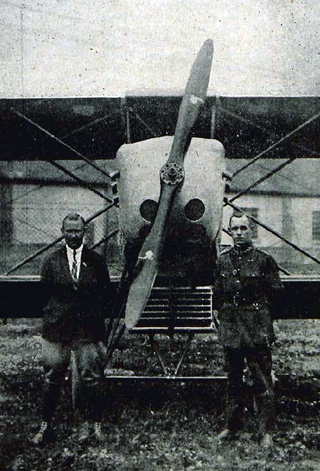
SNCASE or Sud-Est was a French aircraft manufacturer. The company was formed on February 1, 1937, by the nationalization and merger of Lioré et Olivier, Potez, CAMS, Romano and SPCA.

The Hanriot H.230 was a French twin-engined advanced trainer. The construction of the aircraft was initiated in 1936 by Hanriot's chief designer Montlaur. The aircraft was produced by the nationalized factory SNCAC.

Potez 25 was a French twin-seat, single-engine sesquiplane designed during the 1920s. A multi-purpose fighter-bomber, it was designed as a line aircraft and used in a variety of roles, including fighter and escort missions, tactical bombing and reconnaissance missions. In the late 1920s and early 1930s, Potez 25 was the standard multi-purpose aircraft of over 20 air forces, including French and Polish. It was also popular among private operators, notably mail transport companies.

The Bleriot-SPAD S.51 was a French fighter aircraft developed in 1924 in response to a French Air Force requirement for an aircraft to replace their obsolete Nieuport-Delage NiD.29s.

The Blériot-SPAD S.61 was a French fighter aircraft developed in 1923. Designed by André Herbemont, the S.61 was a conventional biplane, abandoning the swept upper wing used by Herbemont in several previous designs. The prototype S.61 was evaluated by the French Air Force alongside the S.51 as a potential new fighter, but like its stablemate, was rejected. The Polish Air Force was impressed enough to order 250, as well as purchase licences for local production. The Romanian Air Force also ordered 100 aircraft. About 30 were built in Poland, by the CWL.

The CAMS 30E was a two-seat flying boat trainer built in France in the early 1920s. It was the first aircraft designed for CAMS by Raffaele Conflenti after he had been recruited by the company from his previous job at Società Idrovolanti Alta Italia (SIAI). It was a conventional design for the era featuring a two-bay equal-span unstaggered biplane wing cellule. The prototype was exhibited at the 1922 Salon de l'Aéronautique and evaluated the following year by the Aéronautique Maritime. The type's favourable performance led to an order of 22 machines for the French military and an export order of seven for Yugoslavia and four for Poland.

The CAMS 37 was a French 1920s biplane flying boat designed for military reconnaissance, but which found use in a wide variety of roles.

The CAMS 55 was a reconnaissance flying boat built in France in the late 1920s which equipped the French Navy throughout the 1930s.

The Morane-Saulnier MS.230 aircraft was the main elementary trainer for the French Armée de l'Air throughout the 1930s. Almost all French pilots flying for the Armée de l'Air at the outbreak of World War II had had their earliest flight training in this machine. It was the equivalent of the Stearman trainer in the United States air services and the de Havilland Tiger Moth in the British Royal Air Force.

The Farman F.190 was a utility aircraft built in France in the 1920s and 1930s. It was a high-wing, strut-braced monoplane of conventional configuration with a fully enclosed cabin and fixed, tailskid undercarriage. Popular both as a private aircraft and in the air taxi role, some 30 examples were also operated by airlines in France and elsewhere in Europe. Fifteen of these joined Air France's fleet in 1933 from the fleets of the smaller airlines it had absorbed.

The FBA 17 was a training flying boat produced in France in the 1920s.
The Hanriot HD.17 was a French trainer seaplane of the 1920s. It was essentially a floatplane version of the ubiquitous HD.14 with a revised tail and a more powerful engine. Over 50 examples were operated by the Aéronautique Maritime, of which seven were converted to landplanes. A small number of HD.17s were exported to Estonia and Latvia. Further development resulted in the HD.41H.

The Hanriot HD.19 was a military trainer aircraft produced in France in the 1920s.

The Hanriot HD.32 was a military trainer aircraft built in France in the 1920s. Derived from the HD.14 and sharing the same basic configuration as it, the HD.32 was a substantially revised design, with redesigned tailplane, undercarriage, and wings of shorter span. The HD.14's wooden construction was replaced in part with metal structure.

The Potez SEA VII, otherwise known simply as the Potez VII, was an early airliner developed in France shortly after the First World War.

The Wibault 7 was a 1920s French monoplane fighter designed and built by Société des Avions Michel Wibault. Variants were operated by the French and Polish military and built under licence for Chile as the Vickers Wibault.

The Société Aérienne Bordelaise (SAB) was an aircraft manufacturing company based in Bordeaux, France. The predecessor company, Société de Travaux Dyle et Bacalan had been founded in 1879.

The Lorraine Hanriot LH.130 is a French racing aircraft designed and built in the early 1930s, to compete in the Coupe Michelin air races.

The Hanriot HD.18 was a three-seat colonial police aircraft built by Hanriot in the early 1920s.
The Hanriot HD.40S was a two-seat medical transport aircraft built in the 1920s, derived from the Hanriot HD.14S.




















